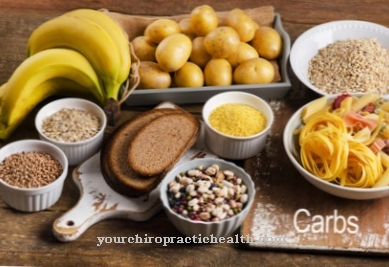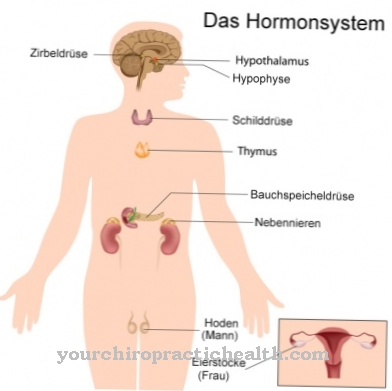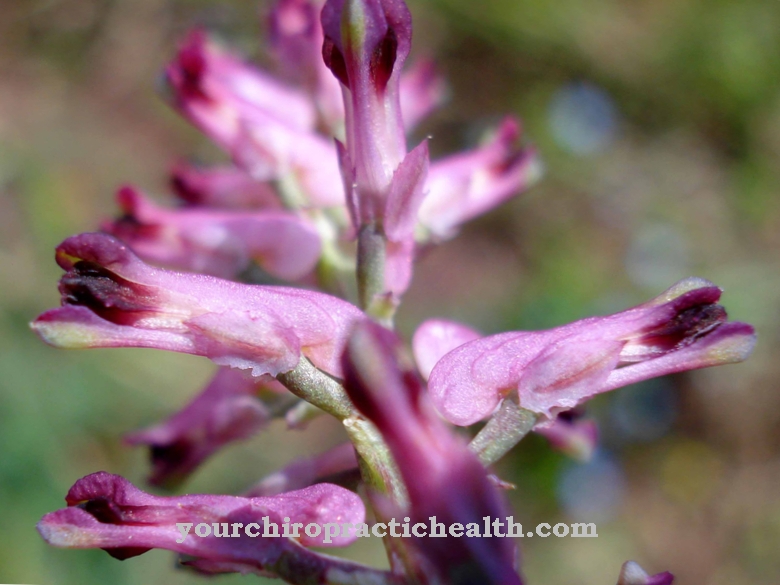Tissue hormones In contrast to other hormones, they are not formed in special glands, but in the immediate vicinity of their places of action. They perform a variety of tasks in the body. Some tissue hormones only act on the cells in which they are produced (cell hormones).
What are tissue hormones?
Tissue hormones are also called Local hormones designated. They perform their task in the immediate vicinity of their place of formation by acting directly on the neighboring cells (paracrine tissue).
They overcome the space in between, which is filled with blood vessels, nerve fibers and connective tissue, and use it to reach the receptors of the targeted cells. The blood circulation is not required as a transport route. There are also local hormones that only affect endocrine tissue. Examples of tissue hormones are prostaglandins (PG), serotonin, histamine, bradykinin and hormones regulating the gastrointestinal tract (substance P). If the tissue hormone acts directly on the cells in which it is produced, it is referred to as a cell hormone.
Function, effect & tasks
Tissue hormones use the principle of diffusion to spread into the surrounding paracrine or endocrine tissue. Locally acting hormones influence metabolic processes and regulate body growth and sexual maturity.
They are permanently controlled by the central nervous system and higher-level hormones. For example, they are released by a stimulus in the central nervous system. They are also released in order to maintain the hormonal balance (control loop). Prostaglandins (PG) belong to the group of eicosanoids. As pain mediators, they convey the sensation of pain; in the stomach they are involved in building up the mucous membrane that protects the stomach. In the case of vascular inflammation, they prevent the clumping of blood platelets and therefore the occurrence of thromboses and embolisms. They widen blood vessels and contract the muscles. In glaucoma, they lower the pressure inside the eye.
The prostaglandin groups E1 and E3 prevent undesirable effects of prostaglandin E2 such as the development of fever. The tissue hormone serotonin acts on the 5 HT receptors. It is mainly active from the intestinal mucosa and influences memory performance and mental well-being. As a "happiness hormone" it ensures a good mood and better coping with stress. It reduces the feeling of hunger and regulates the body temperature. Histamine, which also functions as a neurotransmitter, is released during inflammatory reactions. By stimulating the H2 receptors, it stimulates gastric juice production.
In the case of inflammation, the release of histamine leads to tissue swelling at the target site and to widening of the blood vessels - measures that are intended to support the immune response in the affected area. In addition, high levels of histamine release can cause allergic symptoms such as runny nose, watery eyes and a rash. The histamine releases other neurotransmitters via the central nervous system.
Education, occurrence, properties & optimal values
Tissue hormones are formed in specialized single cells and, in contrast to glandular hormones, can be distributed over large tissue regions. Prostaglandins were first discovered in the secretion of the male prostate (hence the name). They are particularly prominent in male sperm, but are also found in many organs.
Prostaglandins are made from the fatty acids gamma-linolenic acid, eicosapentaenoic acid and arachidonic acid - unsaturated fatty acids made up of 20 carbon atoms and a closed 5-carbon ring. There are prostaglandin groups D2, E1, E2, E3 etc. Histamine is formed from histidine. The body also makes it from certain foods like cheese, yeast, and chocolate. It occurs almost everywhere (skin, lungs, hypothalamus, gastrointestinal tract) and in increased quantities especially in the mast cells, gastric mucosal cells and basophilic granulocytes.
About 95% of serotonin is formed in the gastrointestinal tract and also serves as a neurotransmitter. L-tryptophan is required for its production in the brain, as the body cannot produce serotonin itself. Tryptophan is found in high concentrations in certain foods (nuts, soybeans, mushrooms, sunflower seeds), but must first pass the blood-brain barrier. Sport makes it easier for L-tryptophan to pass into the brain and thus increases serotonin production and distribution.
Diseases & Disorders
Man-made prostaglandins dilate the peripheral arteries in patients with peripheral arterial occlusive disease (PAOD) in stages III and IV. They imitate the effect of the natural prostaglandin E1.
They are also used to heal and prevent ulcers and gastrointestinal infections. As an E2 analogue, they are used to induce artificial labor and prevent atonic uterine bleeding. If there is a prostaglandin deficiency, groups E1 and E3 are inadequately produced. They usually inhibit the undesirable effects of the E2 group. As a result, allergic reactions occur. Serotonin deficiency leads to depressive moods, bad mood, irritability, increased anxiety and migraines. It is caused by a lack of vitamin B6 and magnesium and is treated with antidepressants that act directly on the brain.
In addition, the consumption of coffee, meat and dairy products has an adverse effect on the formation of serotonin. The consumption of L-tryptophan-containing foods such as bananas, nuts, amaranth, mushrooms and chocolate, on the other hand, boosts serotonin production. With histamine intolerance, the body's ability to break down the tissue hormone histamine is impaired. The DAO enzyme required for this only works inadequately. This leads to an excess of histamine and inflammatory and allergic reactions. The patient reacts to the consumption of chocolate, sulfurized dried fruit, cheese and red wine with a rash, headache, diarrhea, nausea, runny nose and puffy eyes.
Sometimes there are even long-term consequences (migraines, eczema). Histamine intolerance is often caused by antibiotics that have an adverse effect on intestinal bacteria. It is also caused by a lack of vital substances.


.jpg)


.jpg)


















.jpg)



